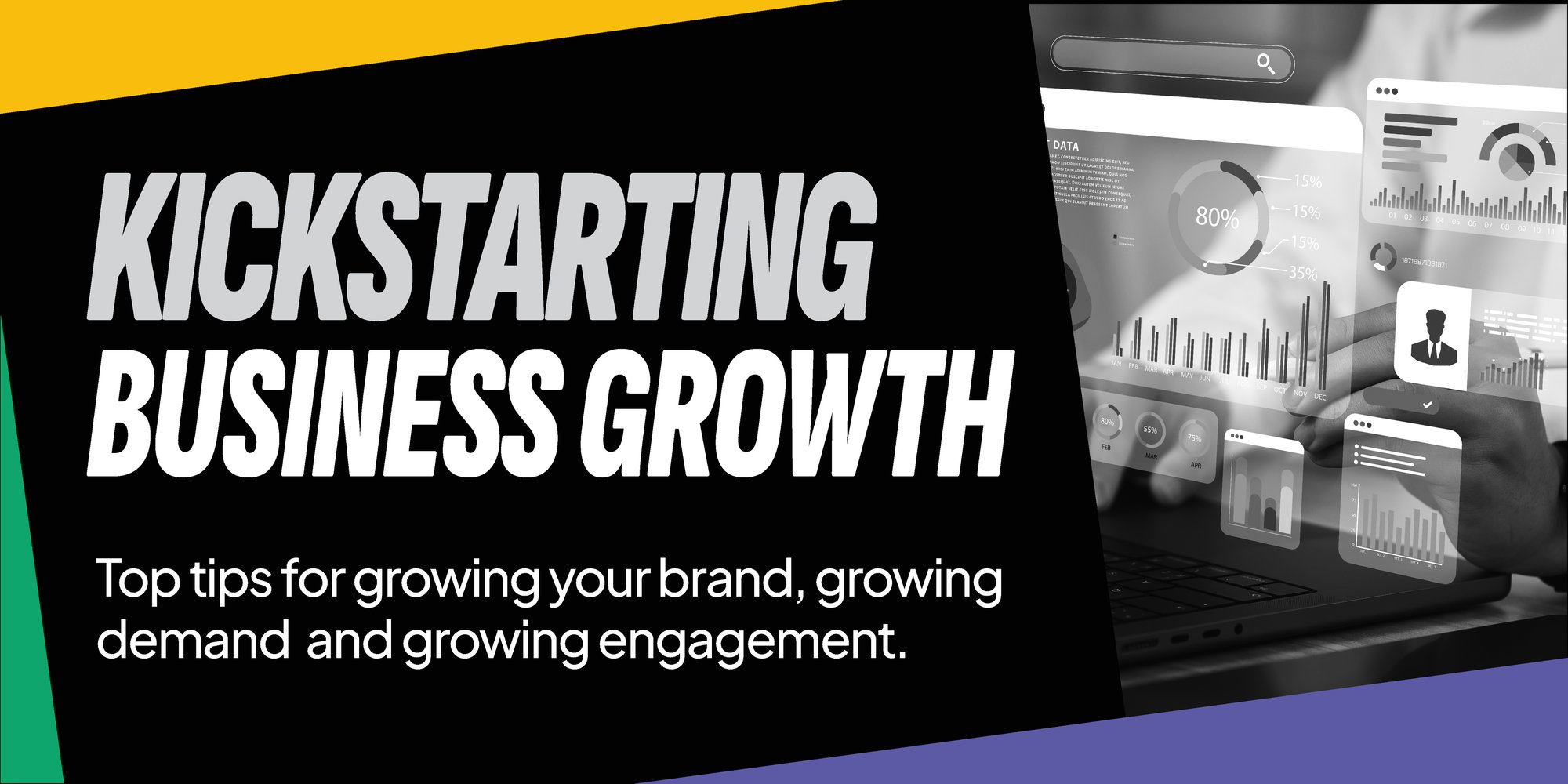Building brand, demand & engagement: 3 ways to kickstart business growth

The last few years have been full of twists and turns for businesses in every sector.
And with an election confirmed, current economic stagnation and continual AI developments, the turbulence of the last 4 years is only set to continue throughout 2024. Budgets are being squeezed, bringing challenges like driving customer growth against significant economic headwinds.
Which is why we’re going to share our top tips for growing your brand, growing demand, and growing engagement in 2024. Let’s get started.
1: Growing your brand
Brand growth is all about establishing a clearly defined position in the market you operate in and developing an identity based on a value proposition that appeals to your audience.
It’s easy for consumer brands to be drawn into a strategy focusing on short-term commercial goals, with tactical activity and product-driven messaging designed to drive short term sales volumes. And business-to-business organisations can be focused on immediate lead generation activities - without considering where they are positioned in the minds of the business buyer (who may not be aware of what they do and why they should be considering the brand in the future.) However, both B2C and B2B brands need to think longer term by building customers’ understanding of the brand and reinforcing their point of difference around quality and value.
Whether you’re a B2B or B2C brand, you’re likely to have many of the same thought processes when it comes to brand growth:
Budget is limited
This shouldn't mean developing your brand proposition is off the table. It’s something that can be reviewed to make sure you’re making the most of opportunities in the market, and that it’s always reflective of the product and service you offer.
Your brand proposition can be developed through engagement with key stakeholders within your organisation and refinements to the value proposition. This can then be applied to your brand story to refresh your go-to market communications.
If budget is restricted, you can focus on growing your brand organically using social platforms, SEM and email marketing to strengthen visibility. By nurturing customers into advocates, you can provide the case for additional marketing investment.
My brand doesn’t stand out for what makes us different
It’s true that significant brand growth doesn’t happen overnight. But there are some areas where it pays to invest time into something that will become a key part of your long-term growth strategy. One of those areas is developing your brand around your point of difference and using this differentiator as fuel to grow beyond your competitors.
It could be that you offer market leading customer service and support; that the quality of your products or services surpasses that of your peers; or that you offer a more customer-focused experience. By leaning into this point of difference in your marketing, your brand will become synonymous with the thing that sets you apart – which will drive customer growth.
Spotting opportunities for growth
It’s understandable that you’d be wary about investing in your marketing efforts during the current economic uncertainty. But if you take a strategic approach to marketing planning, you'll be in a position to make informed decisions on when to take advantage of opportunities that present themselves - and gain market share when your competitors may be reducing their budget or retreating from the market.
How to spot the opportunities
From a strategic perspective. there are several different approaches and methods that you could use to spot opportunities within marketing for your business.
- Competitor activity audits: identify your direct and indirect competitors and review what channels, messages and tactics they’re using.
- Market positioning maps: assessing your brand against the competition will help uncover market gaps and understand customer perceptions. It will help you visualise where you sit to inform strategic decision-making; identify competitive advantage to pinpoint where you put your marketing efforts; and drive future product development and positioning strategies.
- Developing a SWOT analysis: take time to look at the Strengths, Weaknesses, Opportunities and Threats both within your business and the market you’re competing in.
- Market research: when was the last time you really understood the marketplace? Take the time to review competitor positionings and the needs and behaviours of consumer and business decision makers. This will help you understand your market as a whole – and incorporate a SWOT analysis to identify potential opportunities for growth.
- Talk to customers! This is one that’s often forgotten, but it’s essential to talk and listen to the feedback of your customers. What do they think you’re doing well? Is there anything they want or need but don’t feel they’re getting? Customer research provides insights that drive the development of new products, services, propositions and campaign messages.
2: Growing demand
Demand marketing is all about connecting with potential customers and generating interest in your product or service, with a view to boosting sales and growing your business. Not to be confused with lead generation, demand generation is about showing your customers exactly why your product or service is beneficial to them, and the key problem(s) it solves.
There can be many reasons why demand for a brand stagnates at one point or another – it could be that their proposition has become outdated, they’ve lost sight of their customers’ needs, or reduced their marketing spend and let the brand become less visible against the competition. It’s about identifying these potential pitfalls and taking steps to make sure you don’t fall into them.
The answer can be in the data
Embrace your data and the technology and solutions that enable your understanding of these insights. This can inform the way you define prospect audiences and the content those audiences will be looking for. The answers may already be in your business's first party data, so your first port of call should be to gather this data and begin to build a picture of your audience’s behaviours and preferences.
I don’t have the budget for a demand campaign
If this budget is tight, you need to focus on the demand that’s already there in the market. Focusing spend on audiences that are showing clear intent displayed through their behaviour – whether that’s what they’re searching for or content they’re interacting with – is a cost-effective way to nurture and grow demand. It’s about making the money you do spend as effective as possible.
I don’t know which channels will have the biggest impact
Develop a well-defined strategy that aligns your sales and marketing efforts across all channels, guiding your customers’ decision-making at every opportunity. With a strategy built around a clear understanding of the journey your potential customer is on toward their purchase decision, you'll improve the relevancy of messages and offers in the places they’ll make the biggest impact.
My brand proposition and strategy has become outdated
Focus on creating consistent and memorable experiences to evoke emotions and build relationships. Customers are no longer content with transactional relationships with brands, so make sure you consider how you can provide an experience that goes beyond that of your competitors.
3: Growing engagement
“Marketers say the interests or hobbies of their target audience is the most helpful data point, closely followed by consumers’ shopping habits, where they consume content/media, and the products they are interested in buying.” (Hubspot)
Despite this, marketers are thought to only be using an average of 3-4 out of 10 techniques that drive engagement – meaning they’re missing out on a large percentage of opportunities to engage with their audience.
When setting engagement KPIs, it’s easy to consider all engagement as good engagement. However, it’s important to be aware of vanity metrics - just because the result looks impressive, doesn’t mean it supports business objectives. For example, the more social followers a brand has could be a good indicator of awareness and engagement - or it could be a result of a competition they ran where users had to follow the page to enter. These users may never interact with the brand again, but have contributed to (an often temporary) spike in followers. On the other hand, a positive comment, a content download, or a 90% video view rate are much more considered engagements, and a better indicator of how engaged the audience is.
So despite what some people may think, engagement just isn’t about comments, likes, and shares on social media. Engagement KPIs vary across platforms and are aligned to your strategy goals. Meaningful engagement metrics can include:
- Page visits – including time on site and time on page
- Testimonials
- Email open and bounce rates
- Conversions
- Content downloads
If you have any of these common problems relating to building engagement, there are solutions:
I don’t know how to engage with my customers
The sweet spot of engagement is reaching your customers without exhausting them. The average length of uninterrupted time for a desk-based worker is 2.7 minutes, so you need to make sure your messages are relevant for the audience to capture and retain their attention in this time. Using data to understand your customers will ensure you can increase the relevance of your product, service, or communication at the right time, nurturing both conversations and purchases.
I don’t have the right people and resources to deliver more effective customer engagement
Driving customer engagement begins by bringing your whole team onboard for the journey. If you devise a new strategy without involving your team, motivation can plateau, and you won’t see the desired results. On top of this, people want to buy from real brands – so it’s important to elevate your employees’ voices through activities like social media takeovers, Q&As and even direct customer conversations. This could make all the difference to your engagement rates.
Our content and communications are not resonating
Sometimes you can spend time and money creating content that just doesn’t work. But instead of persevering with content that isn’t having the desired effect, often it pays to know when to try something new – and this doesn’t have to come at a great cost. Building your presence as an industry thought leader could start with sharing free expert advice, and creating more informative, evergreen content that appears organically in customers’ feeds.
These top tips are a great place to start to kickstart business growth. For more support with your strategy, speak to STM REACH – we’re here to boost your brand through perpetual thinking.

STM Agency Supports Rising BMX Star Leo
At STM Agency, we are committed to giving back and making a positive impact on our local community. That's why we're proud to announce our support for the up-and-coming BMX star, Leo, who is joining the BeStrong BMX team alongside the renowned Great British athlete, Ross Cullen.

A showcase of Northern talent: Our day at Two+Two
Catherine MacDonald and Rachael Hill attended the 7th edition of Two+Two in Stockport, offering mentorship to marketing and creative students. They spent the day immersed in inspiring talks, hands-on creativity, and plenty of tea, helping guide the next generation of talent in the region.



